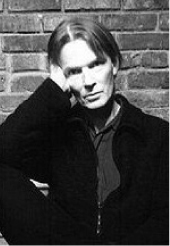 |

|
|||||||
|
The Life of Jim Carroll “All writers of confessions, from Augustine on down, have always remained a little in love with their sins.” Carroll’s poetry and prose served an identical purpose. Both had the brilliant conversational immediacy, insight and humor associated with writers of the Beat Generation. Born in New York City in 1949, the poet, musician and diarist Jim Carroll was first known as a basketball star when he attended Trinity High School in Manhattan. His descent into drug addiction was well documented in his book, The Basketball Diaries, later turned into a film starring Leonardo DiCaprio as the drug-addled teenage Carroll. Carroll’s first volume of poetry, Living at the Movies was published in 1973. His second diary, Forced Entries, captured the New York City scene in the early 1970s. I heard Carroll read excerpts from Forced Entries – tangents and anecdotes about Max’s Kansas City, drugs, sex, madness, suicide. Tragic characters living on the fringes of society were brought to life with a sweetness and humor that made the whole scene sound as innocent as a 1950s family sitcom. That was part of Jim’s gift. We always felt like he was essentially a good guy. Jim was a friend. His great storytelling ability allowed the audience to trust him. We knew he’d bring us back from these dark places unscathed but wiser for the journey. Drugs and sex aside, Carroll was an amazing talent steeped in classic literature. His influences were Frank O’Hara, John Ashbery and the New York school of poets. A 13-year-old Carroll was supposedly introduced to Jack Kerouac. Kerouac was said to have proclaimed that young Carroll was writing better than 80 percent of the writers of that time. Carroll sought out legends. His books tell of his literary encounters with writers William Burroughs, Terry Southern and the like, with all of the stuttering shyness you would expect from an up-and-coming poet meeting his idols. Influenced also by his friend Patti Smith, he formed the Jim Carroll Band. Catholic Boy, released in 1980, was considered a monumental album of the New York punk rock movement. His most popular song, “People Who Died”, was an opus to all his friends who, as Carroll would say, “… died by an age thought predetermined through the timing of their abuses and excesses.” Dark, yes, but this anthem of love to friends lost is as upbeat, ebullient and life affirming as any song about death can be. About his music career, Carroll said, “When I first started I just relied strictly on passion because I wasn’t technically a good singer … The engineer asked me if I ever hurt myself when I sing because I just get so tight when I do it. It’s harder for me to relax when I sing.” Unlike many of his friends, Jim Carroll outlived his abuses and excesses. Still, a voice so unique is always gone too soon. Now it’s our turn to take on the bittersweet task of celebrating the life of a lost friend. This one’s for Jim. To quote “People Who Died”, ”I salute you, brother!” Sharon Anderson is an artist and writer in Southern California. She can be reached at www.mindtheimage.com
|
||||||||
 |
||||||||
|
||||||||
|
||||||||
|
||||||||

|
||||||||

|
||||||||



